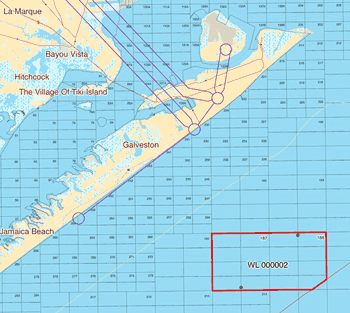n the parish of Iberia, La., not far from the rookeries and gardens of McIlhenny-founded Avery Island, a small alternative energy company is doing its part to rebuild a region’s energy infrastructure — and simultaneously rebuild a hurricane-ravaged economy — using the same natural force that has wrought so much destruction.
After securing a 30-year lease on 11,355 acres (4,595 hectares) of underwater land from the State of Texas, Wind Energy Systems Technologies (W.E.S.T.) of New Iberia plans to build the nation’s first offshore wind farm off the coast of Galveston. Thus has a community in the strike zone of Rita suddenly become the target of a $300-million project, expected to pump at least $26 million into the public school system.
But the vision of former oil and gas exploration expert Herman Schellstede, president of Wind Energy, doesn’t stop there. For some time he has advocated the construction of wind turbines on the very platforms in the Gulf that are now home to oil and gas rigs.
Now, in a region literally shorn of its coastal landmarks, Schellstede seeks to create one, building on the legacy that his father, among others, helped create.
The senior Schellstede, it turns out, was one of the men who served on the first-ever offshore rig in the Gulf, back when the shrimpers were fighting to keep oil and gas development away. Today, some 5,200 rigs populate the Gulf off the Louisiana shore alone.

|
| The $300-million wind farm going into the location marked by red represents a new kind of Texas offshore development.
Source: Texas General Land Office |
Schellstede’s company, based in New Iberia, La., is in its 37th year of offshore oil and gas development, and has always studied the wind as part of its due diligence. He can add his own experience too.
“In 1956, Hurricane Audrey killed 500 people in Cameron, Louisiana,” he says in an interview. “I stayed on the platform as the hurricane went by us — that was really an ordeal.” The more recent ordeals of Katrina and Rita took their tool on New Iberia and on W.E.S.T., which saw three employees lose their homes. When the company is in fabrication it employs up to 500 people, but now consists of up to 25 white-collar workers. That number will almost double to staff up for the Galveston project.
Why Texas and not Louisiana? Schellstede says that even though his home state has begun to study renewable energy, its public service commission has not allowed an avenue to sell renewable power. “That’s why we decided to go to Texas,” he says, where the company signed on to “a remarkable deal” after seven months of negotiation.
The remarkability extends through both space and time. In 1845, when Sam Houston was negotiating for Texas to retain its sovereignty, one of the provisions was that Texas would retain ownership of land extending three marine leagues — or 10.36 miles (16.7 km.) — out from its shore. That provision endures, while every other state in the Union gets a mere three miles (4.8 km.). The exception endured a federal challenge in the 1950s.
Not only will the site be out of sight of land, it will boast stronger and more constant winds than some onshore wind farms. Having a nearby place to take the power is part of the deal too.
“The beautiful part is that it will bring in power to Galveston,” says Schellstede. “They can accept at least 300 megawatts into that area. It’s an excellent situation, bringing power where it’s being used, whereas in West Texas, you may have to transmit 300 miles [483 km.].”
Asked how the new structures will stand up to the very hurricane forces that make the region’s annual wind velocity average so high, Schellstede says the design will differ from the single-caisson design popular in the North Sea in Europe. “We’re designing for a Category 5 hurricane,” he says, citing the solid storm performance of his firm’s rigs over the years. “We also have a way of storing our blades in a direct hit.”
Another difference from similar projects off the coast of England is that this one will not be fighting migratory bird activists who so often oppose the turbines for their alleged killing of birds sucked into their vortices. “One of my partners, Harold Schoeffler, is the chair of the Sierra Club of Acadiana, and also a board member of the Audubon Society,” says Schellstede.